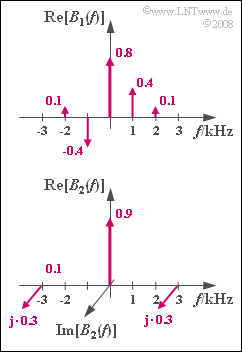Exercise 3.3: Sum of two Oscillations
The equivalent low-pass signal with phase modulation, when normalized to the carrier amplitude (AT=1) is:
- sTP(t)=ej⋅KPM⋅q(t),
The modulator constant is assumed to be KPM=1/V throughout the task.
The upper graph shows the corresponding spectral function B1(f), when the source signal is
- q1(t)=0.9V⋅sin(2π⋅1kHz⋅t)
The weights of the Bessel-Dirac lines when η_1 = 0.9 are obtained as follows:
- {\rm J}_0 (0.9) = 0.808 \approx 0.8,\hspace{1cm} {\rm J}_1 (0.9) = 0.406 \approx 0.4,
- {\rm J}_2 (0.9) = 0.095 \approx 0.1,\hspace{1cm} {\rm J}_3 (0.9) \approx {\rm J}_4 (0.9) \approx\ \text{ ...} \ \approx 0 \hspace{0.05cm}.
Use the approximations given in the graph to simplify the calculations.
The Bessel function B_2(f) is obtained for the source signal
- q_2(t) = 0.65\,{\rm V} \cdot \cos(2 \pi \cdot 3\,{\rm kHz} \cdot t)
The numerical values of the Dirac lines are obtained from the following:
- {\rm J}_0 (0.65) = 0.897 \approx 0.9,\hspace{0.3cm}{\rm J}_1 (0.65) = 0.308 \approx 0.3, \hspace{0.3cm}{\rm J}_2 (0.65) = 0.051 \approx 0\hspace{0.05cm}.
From the graph, it can be seen that due to the cosine source signal q_2(t) and the cosine carrier signal z(t) , the spectral lines at ±3 \ \rm kHz are both positive and imaginary.
In the context of this task, we will now investigate the case where the source signal
- q(t) = q_1(t) + q_2(t)
is applied to the input of the phase modulator.
- It is worth mentioning that |q(t)| < q_{\rm max} = 1.45 \ \rm V .
- This maximum value is slightly smaller than the sum A_1 + A_2 of the individual amplitudes when a sine and a cosine function with the given amplitudes are added up.
In the following questionnaire,
- S_{\rm TP}(f) denotes the spectral function of the equivalent low-pass signal,
- S_+(f) denotes the spectral functions of the analytic signal,
in both cases assuming that q(t) = q_1(t) + q_2(t) holds and that the carrier frequency is f_{\rm T} = 100 \ \rm kHz .
Hints:
- This exercise belongs to the chapter Phase Modulation.
- Particular reference is made to the page Equivalent low-pass signal in phase modulation.
- The values of the Bessel functions can be found in formula collections in table form.
- You can also use the interactive applet Bessel functions of the first kind to solve this task.
Questions
Solution
- In angle modulation, the complex pointer s_{\rm TP}(t) always moves on a circular arc with the following opening angle:
- 2 · K_{\rm PM} · q_{\rm max} = 2 \cdot {\rm 1/V} \cdot 1.45 \ \rm V = 2.9 \ \rm rad \approx 166^\circ.
- Using the (admittedly very rough) approximation 166^\circ \approx 180^\circ we indeed get a semicircle.
(2) In general, S_{\rm TP}(f) = B_1(f) ∗ B_2(f) holds.
- Since B_1(f) is limited to the frequencies |f| ≤ 2 \ \rm kHz and B_2(f) is limited to the range ±3 \ \rm kHz , the convolution product is limited to |f| ≤ 5 \ \rm kHz .
- It follows that:
- f_{\rm min} \hspace{0.15cm}\underline {= -5 \ \rm kHz},
- f_{\rm max} \hspace{0.15cm}\underline {=+5 \ \rm kHz}.
(3) The convolution product for frequency f = 0 results from multiplying B_1(f) with B_2(f) and summing.
- Only for f = 0 are both B_1(f) and B_2(f) non-zero.
- Thus, we get:
- S_{\rm TP}(f = 0) = B_{1}(f = 0) \cdot B_{2}(f = 0)= 0.8 \cdot 0.9 \hspace{0.15cm}\underline {= 0.72}\hspace{0.2cm}{\rm (rein \hspace{0.15cm} reell)} \hspace{0.05cm}.
(4) Now, before multiplication and summation there needs to be a frequency shift of B_2(f) to the right – or of B_1(f) to the left– by 1 \ \rm kHz . This gives:
- S_{\rm TP}(f = 1\,{\rm kHz}) = B_{1}(f = -2\,{\rm kHz}) \cdot B_{2}(f = 3\,{\rm kHz}) + B_{1}(f = 1\,{\rm kHz}) \cdot B_{2}(f = 0) = 0.1 \cdot {\rm j} \cdot 0.3 + 0.4 \cdot 0.9\hspace{0.15cm} = 0.36 + {\rm j} \cdot 0.03
- \Rightarrow \hspace{0.3cm} {\rm Re}[S_{\rm TP}(f = 1\,{\rm kHz})] \hspace{0.15cm}\underline {= 0.36} \hspace{0.05cm},\hspace{0.3cm} {\rm Im}[S_{\rm TP}(f = 1\,{\rm kHz})] \hspace{0.15cm}\underline {= 0.03} \hspace{0.05cm}.
(5) The Dirac line S_+(f = 98 \ \rm kHz) corresponds to the S_{\rm TP}(f)–line at f = -2 \ \rm kHz. This is
- S_{\rm TP}(f \hspace{-0.05cm}=\hspace{-0.05cm} -2\,{\rm kHz}) \hspace{-0.03cm}=\hspace{-0.03cm} B_{1}(f = -2\,{\rm kHz}) \cdot B_{2}(f \hspace{-0.05cm}=\hspace{-0.05cm} 0) + B_{1}(f \hspace{-0.05cm}=\hspace{-0.05cm} 1\,{\rm kHz}) \cdot B_{2}(f \hspace{-0.05cm}=\hspace{-0.05cm} -3\,{\rm kHz})= 0.1 \cdot 0.9 + 0.4 \cdot {\rm j} \cdot 0.3 \hspace{0.15cm}\hspace{-0.03cm}=\hspace{-0.03cm} 0.09 + {\rm j} \cdot 0.12
- \Rightarrow \hspace{0.3cm} {\rm Re}[S_{\rm +}(f = 98\,{\rm kHz})] \hspace{0.15cm}\underline {= 0.09} \hspace{0.05cm}, \hspace{0.3cm} {\rm Im}[S_{\rm +}(f = 98\,{\rm kHz})] \hspace{0.15cm}\underline {= 0.12} \hspace{0.05cm}.
